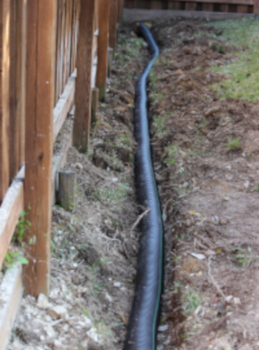With a wealth of drainage systems available, it’s understandable that you may be confused as to which one is suitable for your specific garden landscaping project. In this blog, we dive specifically into French drainage systems – not the latest Parisian fashion trend, but a garden game-changer you never knew you needed. It’s easy to picture your ideal garden as a serene sanctuary of blooming flowers and lush greenery, but could it survive a torrential downpour without turning into a muddy mess? We take a detailed look at French drainage systems so you can figure out if your garden is secretly dreaming of one. Get ready for some muddy talk and a sprinkle of landscaping wisdom!
What is a French drain?
Often referred to as a gravel or trench drain, a French drain is designed to manage excess water by redirecting it away from a particular area. It typically consists of digging a trench into the ground and backfilling it with gravel and a perforated pipe. The gravel allows water to flow easily into the pipe, so you can channel the water away from the problematic area deep under the ground so it can seep out and disseminate into the substrate.
They are popular in gardens where water accumulation is common near to the walls of the house or in other areas in the garden or driveway that are prone to flooding such as waterlogged lawns, basement flooding, or any area with poor drainage and a risk of soil erosion.
If you are environmentally conscious, creating an eco-friendly French drain is a fantastic idea to harmonise your garden with the environment. Consider using recycled materials for the gravel and pipe:


For the gravel component, consider using crushed recycled concrete or reclaimed asphalt. These materials not only repurpose waste but also provide excellent drainage. As for the pipe, high-density polyethylene (HDPE) pipes made from recycled plastic are a superb choice. They are durable, corrosion-resistant, and give a second life to plastic that would otherwise end up in landfills. By opting for these recycled gems, you’re not just improving water management in your garden; you’re also giving a nod to sustainability and responsible landscaping. Mother Nature would surely give you a thumbs-up!
Additionally, planting native, water-loving plants along the drainage path can help absorb excess water and contribute to a more sustainable solution.
This is an example of a recent gravel drain we installed. You can see we have installed the drain and then covered with lawn and a permeable path:


How do French drains work?
French drains operate on the principle that water doesn’t linger on the surface but instead infiltrates the designated trenches to find its way to a drainage destination.
Luke Richards, Owner of Terra Firma Landscapes, London adds: “Water makes its way into the gravel-filled trench, flowing into a perforated underground pipe within that very trench. The water then follows the pipe’s course, ultimately emptying into a soakaway, drainage ditch, or any other suitable drainage outlet. To safeguard the drain from sediment infiltration, the trench is lined with a filter membrane – we source most of our drainage supplies from Drainage Superstore.”

Is a French drain the same as a soakaway?
No. Unlike soakaways, which are a pit in the ground into which you run your rainwater drainage. French drains are used to prevent water logging and an excess of surface water.
Where should I put a French drain?
For most effective water management, you need to be strategic with the placement of a French drain – aim for the lowest spot in the flood-prone zone you’re tackling. Water always tends to find its way to the lowest point in an area, so that is where your French drain will be most effective. Picture it like choosing the VIP seat for water evacuation.
When plotting the path for your garden drain, scan the area and make sure there are no sneaky obstacles like pipes, cables, or stubborn trees that might mess with the water’s smooth getaway. We want the water to flow freely, no obstacles allowed.
The depth and width of your French drain will largely depend on how much water needs to drain. It is always better to overestimate! A professional landscape gardener will be able to advise on how wide and deep to dig your drench when assessing and designing your garden project with you.
Where not to put a French drain?
Avoid installing a French drain at high points, close to building foundations (this might mess with the soil around the foundation), over utility lines, in tree roots zones (trees and drains don’t always play well together. Roots can invade pipes and cause all sorts of underground chaos), or underneath large structures. Choose its location wisely, and your drainage system will flow smoothly without any hiccups.
In summary, for the best results, strategically place your French drain in the lowest spot of your garden where water tends to gather. It’s like giving water a VIP exit ticket. To keep things eco-friendly, use recycled materials like crushed concrete and HDPE pipes. Planting water-loving plants along the drain path adds a sustainable touch.
Here’s the basic idea: Water slides into a gravel-filled trench, flows through a pipe, and exits through a drainage outlet. Just make sure the trench is lined to keep it clean. For the right depth and width, chat with a pro landscaper like the team at Terra Firma Landscapes on 020 8769 7321 or info@terrafirmalandscapes.co.uk.
And don’t forget the no-go zones: avoid high spots, building foundations, utility lines, tree roots, and big structures. Pick the right spot, and your French drain will keep your garden happy, rain or shine!












